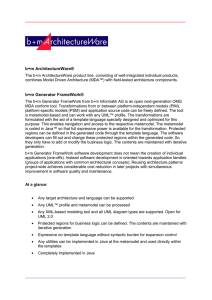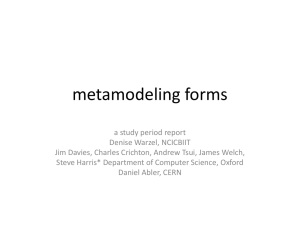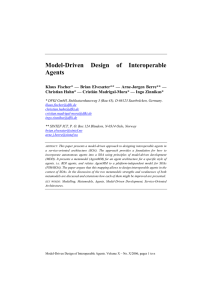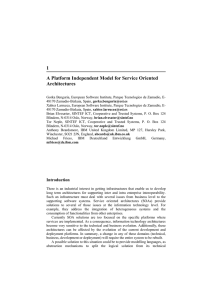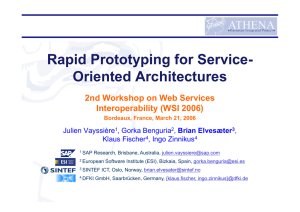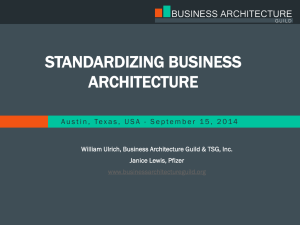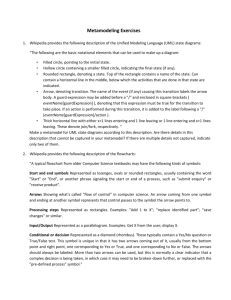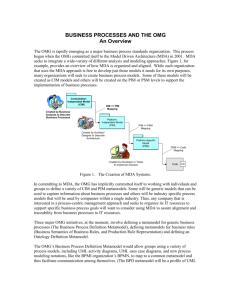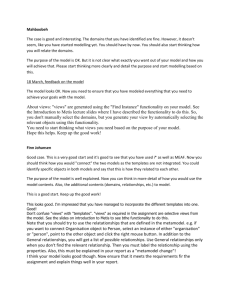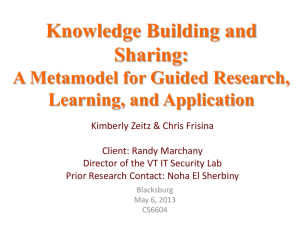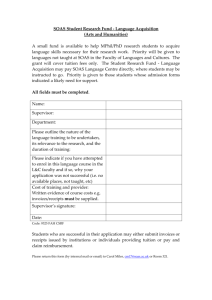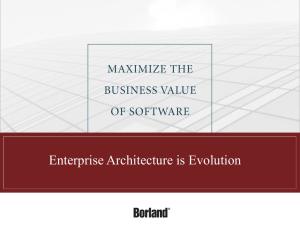Meta-models, Models, and Model Transformations: Towards Interoperable Agents
advertisement
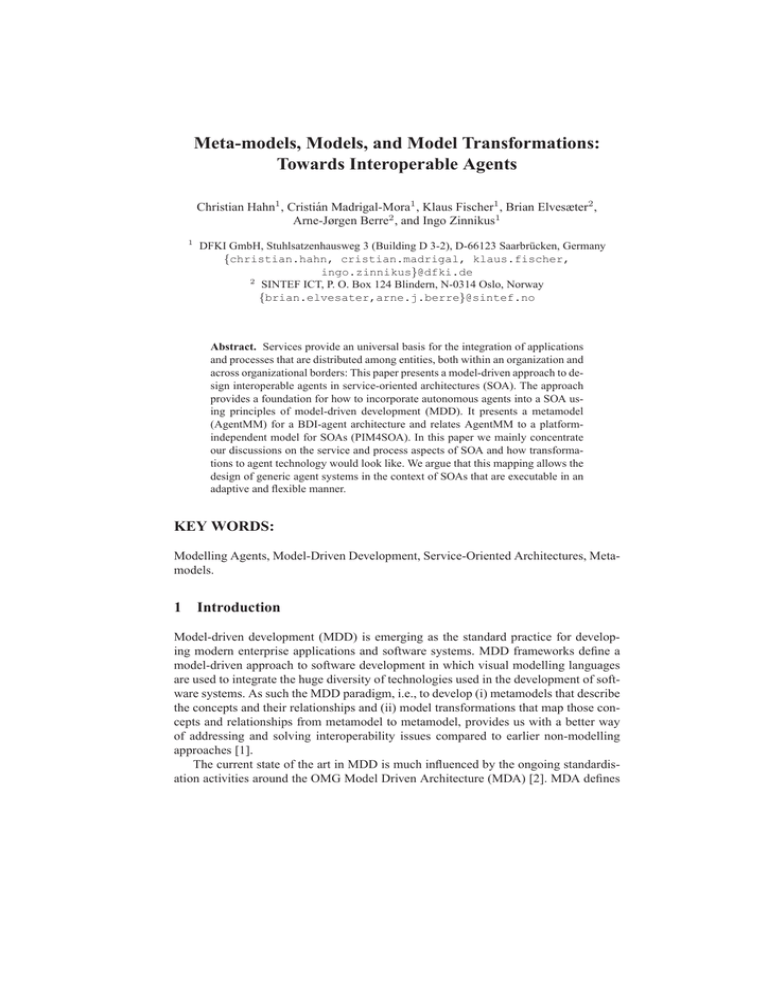
Meta-models, Models, and Model Transformations:
Towards Interoperable Agents
Christian Hahn1 , Cristián Madrigal-Mora1 , Klaus Fischer1 , Brian Elvesæter2 ,
Arne-Jørgen Berre2 , and Ingo Zinnikus1
1
DFKI GmbH, Stuhlsatzenhausweg 3 (Building D 3-2), D-66123 Saarbrücken, Germany
{christian.hahn, cristian.madrigal, klaus.fischer,
ingo.zinnikus}@dfki.de
2
SINTEF ICT, P. O. Box 124 Blindern, N-0314 Oslo, Norway
{brian.elvesater,arne.j.berre}@sintef.no
Abstract. Services provide an universal basis for the integration of applications
and processes that are distributed among entities, both within an organization and
across organizational borders: This paper presents a model-driven approach to design interoperable agents in service-oriented architectures (SOA). The approach
provides a foundation for how to incorporate autonomous agents into a SOA using principles of model-driven development (MDD). It presents a metamodel
(AgentMM) for a BDI-agent architecture and relates AgentMM to a platformindependent model for SOAs (PIM4SOA). In this paper we mainly concentrate
our discussions on the service and process aspects of SOA and how transformations to agent technology would look like. We argue that this mapping allows the
design of generic agent systems in the context of SOAs that are executable in an
adaptive and flexible manner.
KEY WORDS:
Modelling Agents, Model-Driven Development, Service-Oriented Architectures, Metamodels.
1 Introduction
Model-driven development (MDD) is emerging as the standard practice for developing modern enterprise applications and software systems. MDD frameworks define a
model-driven approach to software development in which visual modelling languages
are used to integrate the huge diversity of technologies used in the development of software systems. As such the MDD paradigm, i.e., to develop (i) metamodels that describe
the concepts and their relationships and (ii) model transformations that map those concepts and relationships from metamodel to metamodel, provides us with a better way
of addressing and solving interoperability issues compared to earlier non-modelling
approaches [1].
The current state of the art in MDD is much influenced by the ongoing standardisation activities around the OMG Model Driven Architecture (MDA) [2]. MDA defines
three main abstraction levels to software development: from a top-down perspective, it
starts with a computation independent model (CIM), describing the application context
and requirements, that is refined to a platform independent model (PIM), which specifies software services and interfaces independent of software technology platforms.
The PIM is further refined to a set of platform specific models (PSMs) that describes
the realisation of the software systems with respect to the chosen software technology
platforms.
The focus of this paper is on PIM to PSM development, i.e., the basic idea is
to present a PIM for service-oriented architectures (PIM4SOA) [3] and compare it
to a metamodel for a specific (platform-specific) agent architecture (AgentMM). If
PIM4SOA models can actually be translated into and executed by agent models, agent
systems can be built, so that they can really interoperate with competing technologies
in SOAs.
The paper is structured as follows: in Section 2, we present the PIM4SOA metamodel, followed by the metamodel for a specific agent architecture (Section 3). In Section 4, we compare the two metamodels and discuss feasible transformations. Section 5
illustrates related work. Finally, Section 6 presents some conclusions.
2 Metamodel for Service-Oriented Architecture
Services are loosely coupled, dynamically locatable software pieces, which provide
a common platform-independent framework that simplifies heterogeneous application
integration. An approach based on agent technologies can be an interesting opportunity
when executing services, because:
– agents are self-aware and they acquire the awareness of other agents and their attitudes,
– agents are proactive, whereas services are passive until invoked,
– in contrast to services, agents act in an autonomous manner that is required by many
Internet applications,
– agents are cooperative and, by forming organizations, they can provide higher-level
and more comprehensive services.
Current standards in the domain of services do not provide any of those functionalities [4]. The metamodel for SOAs addresses the conceptual and technological interoperability barrier and aims at defining platform independent modelling language
constructs that can be used to design, re-architect and integrate technologies supporting
SOA. The introduction of agents will enable us to design SOAs that are more adaptable
and flexible, and, thus, better able to cope with changes over time—which is important
for supporting interoperability.
In order to support an evolution of the metamodel for SOAs (PIM4SOA) we have
defined a small metamodel core and structured it into groups, each focusing on a specific aspect of an SOA. The current version of the PIM4SOA defines modelling concepts that can be used to model four different aspects of SOAs: Services, information,
processes and non-functional aspects. In this paper, we mainly concentrate on the service and process aspects, where services are an abstraction and an encapsulation of the
functionality provided by an autonomous entity, and processes describe sequencing of
work in terms of actions, control flows, information flows, interactions, protocols, etc.
In general, SOAs are formed by components provided by a system or a set of systems
to achieve a shared goal.
Fig. 1. Service concepts of the PIM4SOA metamodel
The service aspect of the PIM4SOA presents services modelled as collaborations
that specify a pattern of interaction between the participating roles. A subset of the
metamodel for this aspect is presented in Figure 1. The Collaboration specifies the involved roles and their responsibilities. Additionally, a CollaborationUse specifies the
application of a Collaboration in a specific context and includes the RoleBindings to
entities in that context. Collaborations are composable and the responsibilities of a role
in a composite Collaboration are defined through CollaborationUses by binding roles
from the composite to roles of its subcollaborations. The simplest form of Collaboration is the binary collaboration, which has no subcollaborations and only two roles – a
requester that provides the input, and a provider that produces the output parameters.
Therefore, a Role represents how a partner participates in the Collaboration by providing services and parameters and using services provided by other partners in its service
collaboration.
Furthermore, collaborations can have a Process that specifies the constraint that
define how the involved roles interact. We refer to this as the collaboration protocol.
The collaboration protocol is specified from a global view point. Constraints on the
expected behavior of a role can be deduced.
The process elements of the PIM4SOA metamodel are shown in Figure 2. This process aspect is closely linked to the service aspect. The primary link is described by the
Process that belongs to a ServiceProvider. The Process contains a set of steps (generally tasks), representing the actions to be carried out, and Interactions/Flows linking
Fig. 2. Process concepts of the PIM4SOA metamodel
the tasks together. In addition, the Process also contains a set of Flows between these
actions which may indicate the transfer of specific data.
3 Metamodel for BDI Agents
There are several alternatives when it comes to transforming PIM4SOA models into
models that can actually be executed. Agent technologies can provide various contributions to SOAs. For instance, agent technologies allow a flexible and adaptive execution. Also, well-known agent protocols, such as the contract net protocol [5], could be
adopted for the service supplier selection, when the number of suppliers is not know at
design time. This kind of service selection can be nicely described with agent technologies, while a straightforward model for the PIM4SOA is not available. The integration
of agent technologies with PIM4SOAs is therefore a worthwhile enterprise.
For the design of agents with rational and flexible problem solving behavior, the
BDI agent architecture has been proven successful during the last decade [6, 7]. Three
mental attitudes (beliefs, desires, and intentions) allow an agent to act in and to reason
about its environment in an effective manner. A vast number of tools and methodologies
have been developed to foster the software-based development of BDI agents and multiagent systems (MAS) [8–12]. Rather than inventing our own agent metamodel, we took
a bottom-up approach, by extracting the metamodel (AgentMM) from one of the most
sophisticated tools to design BDI agents, namely JACKTM Intelligent Agents3 [13].
Figure 3 presents the most interesting part of this metamodel.
3
JACKTM is the trademark of an agent oriented model developed by Agent Oriented Software
Group. A free evaluation package for JACK Intelligent Agents is available for download.
Fig. 3. Partial metamodel for BDI agents
Table 1 summarizes the most important high-level BDI concepts. From these, the
most relevant one in AgentMM is the concept of Team, which can be either atomic, in
which case we can refer to it simply as an Agent, or a set of required roles—subteams—
that all together form the Team. It is important to note that it is not necessary for all
members of the Team to be involved in all the tasks it performs. Rather, for each individual task, a subset of the available roles is selected to actually work on it. The tasks a
given Team is able to work on are defined by the roles that it is able to fulfill.
High-Level BDI Concepts
Specifies the structure of one or more entities (Teams/Agents)
that is formed to achieve a set of desired objectives
Role
Specifies a role as a type by a listing the types of the events the role can deal with
Named Role An instance of a specific role type.
This concepts allows multiple roles with the same type in teams and team plans
Events
The type of stimuli a team, role, or team plan reacts to or posts
Team Plan Specifies the behavior of a team in reaction to a specific event. In general, a team
plan is a set of steps specifying how a particular task is achieved by particular roles
Named Data Allows the team to store information/beliefs
Table 1. High-Level BDI Concepts
Team
Structure of Plans
Triggering Condition Specification of the event the plan reacts to
Relevance Condition Additional constraints on the triggering event
Context Condition
Constraints on the state of affairs the plan is designed for to deal with.
Usually these constraints access the agents beliefs
Actions that should be taken when the plan becomes active.
Plan Body
Can include pure Java code but allows the use of special concepts
to drive BDI reasoning
Table 2. The JACKTM Plan Structure
Role definitions are the second most important concept to define teams because a
role specifies which messages—in JACKTM those are rather events—the role fillers are
able to react to and which messages they are likely to send.
How a team actually reacts to an incoming request is specified by a set of team plans.
The structure of a plan can be seen in Table 2. Due to space restrictions, we concentrate
in this paper on the concepts of the Plan Body—the core part of a plan. Each team plan
has an explicitly defined objective (incoming message or internal event) for which this
team plan is responsible. When the so-called triggering event is raised and all additional
criteria are valid (i.e. Relevance and Context Condition), a specific team plan is executed
by creating an instance of this team plan. As a consequence, a concrete team (already
known or newly established) to actually execute the team plan is established.
The process aspect of AgentMM is presented in Figure 4 and it provides the constructs to model the body of the Plans and other, so called, reasoning methods (see
Figure 3). The whole package is based on two abstract classes—the ProcessBase and
NodeBase. NodeBase represents the basic node in the plan body graph, it provides a
reference to its default flow node, the next node in the execution order, and references
to the incoming flows, the previous nodes in the execution. ProcessBase is the graph
container that includes a list of all the nodes and a reference to the starting node. The
Process class extends ProcessBase and represents the main component of the reasoning method body. It is also a process node in itself, which permits modelling nested
processes.
Further specialization of the nodes is performed through the ForkNode abstract
class, which adds an alternative output flow to the NodeBase. As shown in Figure
4, the Node classes are separated in two groups: the ones that inherit directly from
NodeBase—only one output flow, and the ones that inherit from ForkNode—with the
alternative output flow. The semantics of the alternative flow varies depending of the
particular node being modelled, for example, in a DecisionNode the alternative flow
represents the else path of the decision, while in a SubgraphNode it represents the
fail path. For detailed semantics of the plan constructs in JACKTM please refer to the
JACKTM Documentation [13].
PIM4SOA
Concepts
Attributes
ServiceProvider →
name
Message
Role
AgentMM
Concepts
Attributes
Team
name
Notes
name of the service provider is
used as team identifier
each role is mapped
to a role performed by the team
for each behaviour/process
a new teamplan is instantiated
roles
rolesPerformed
behaviour
usesPlans
participates
bindings
boundRole
rolesRequired
roles a team makes use of
are specified in the role bindings
the service provider participates
name
name of message is
used as event identifier
name
name of the role (PIM4SOA) is
used as role (AgentMM) identifier
→
name
Event
→
name
Role
messages
handleEvents
roleContainers
min = 1
max = 1
required roles have a min/max
requirement of one filler
Team
name
self
→
name
→
name
name + ’Team’
name of the role plus the extension
”Team” is used as team identifier
rolesPerformed
role itself is mapped to the
team’s performed role
TeamPlan
TeamPlan responsible for
handling service requests
bases on Role (PIM4S0A)
’Receive’ + name name of role acts as identifier
reasoningMethods
body
body contains send method
establish
these reasoning methods
pass
are automatically
fail
generated
handleEvent
handles service requests
postEvents
posts corresponding
asynchronous message
TeamPlan
TeamPlan responsible for
invoking services
bases on Role (PIM4S0A)
’Invoke’ + name name of role acts as identifier
reasoningMethods
body
body contains service call
establish
these reasoning methods
pass
are automatically
fail
generated
handleEvent
handles service requests
Table 3. Partial transformations between PIM4SOA and AgentMM concepts
Fig. 4. Process Metamodel of AgentMM (Plan Body)
4 Comparison of the Metamodels for PIM4SOA and BDI Agents
In this section, we bring together the metamodel concepts from the two previous sections and relate them to one another in a mapping and a transformation derived from
it. Although the concepts from PIM4SOA and AgentMM differ quite significantly the
mapping of PIM4SOA models to AgentMM models seems to be feasible as the AgentMM
is more expressive.
The first element we inspect is the ServiceProvider (presented in Figure 1). At first
glance an agent seems to be the best match, but since a ServiceProvider references roles,
it is recommended to assign it to a team. The name of the ServiceProvider coincides
with the name of the team and its roles are the roles the team performs.
While a ServiceProvider is supposed to represent an atomic team, a Collaboration
is mapped onto a team that may consist of any number of agents. However, since col-
PIM4SOA
Concepts Attributes
Process →
self
Task
Decision
Merge
in
out
Task
AgentMM
Concepts
Attributes
TeamPlan
Notes
Filter: corresponding Team
bases on Service Provider
name + ’TeamPlan’ name := name of service provider
reasoningMethods
body
the process itself is mapped
on the plan body
TeamAchieveNode transform all tasks with an ’in’
Interaction to a TeamAchieveNode
DecisionNode
one-to-one mapping
ForkNode
one-to-one mapping
incomingFlows
one-to-one mapping
defaultFlow
one-to-one mapping
establish
these reasoning methods
pass
are automatically
fail
generated
handleEvent
handle all messages inside a task with
an ’out’ but no ’in’ Interaction
postEvents
post all messages inside a task
with an ’in’ Interaction
roles
roles a team makes use of are
bound in the team plan
Table 4. Partial transformations between the process metamodels
laborations do not specify any cardinalities for roles, we can assume that a collaboration
asks for exactly one filler for each of the required roles. Correspondingly, we suggest
to map collaborations to team structures where the required roles have a cardinality requirement of exactly one role filler. Although the metamodel for PIM4SOA allows to
specify constraints on the behavior of the participating collaborations and their roles,
up to now it is unclear how these constraints might look like.
In practical cases, it turns out that a Process is provided for ServiceProviders and
requester roles only. This allows to use the PIM4SOA model in a manner where the information on Collaborations and CollaborationUses is mapped to a set of teams, where
each of the teams consists of a service requester—represented by the team itself—
and a set of roles this specific service requester makes use of. Due to the fact that
non-composed collaborations in the PIM4SOA are binary, it is always clear who requests and who provides the corresponding service. Interactions other than pure service
requests-provisions do not exist. This matches nicely with the fact that, in JACKTM ,
the interaction of a team as a whole with its attached roles is easy to describe. The behavior of the service requester is therefore mapped to a team plan where each request
of a service from a ServiceProvider is represented by the construct team achieve (see
Table 4), that is sent to the respective role in the collaboration the service is involved in
(which defines which roles are actually attached to the team that represents the service
provider). Thus, the transformation of behavior for service requesters and providers is
stereotyped and can be done automatically.
The transformation between the PIM4SOA and AgentMM is finally done using the
Atlas Transformation Language (ATL) [14, 15] that is a hybrid language designed to
express model transformations as described by the MDATM approach. The transformation model in ATL is expressed as a set of transformation rules. Tables 3 and 4 illustrate
some transformation rules by abstracting from the ATL syntax. The core transformation
is described as ServiceP rovider → T eam in Table 3. In this case, for each ServiceProvider a Team is instantiated that has the same name, performs the same roles and
makes use of the roles specified in the CollaborationUse, in which it participates, as
bound roles. Beside introducing a role in the AgentMM for each role specified in the
PIM4SOA, we define a team and two team plans for every role service providers make
use of (see Role → T eam and Role → T eamP lan in Table 3). These plans specify how the requested service is invoked and how the corresponding team reacts on a
service request.
As discussed before, the process of an PIM4SOA can easily be transformed into
team plans (cf. Table 4). As a first approach, we translated the sequential process structure of an PIM4SOA into a sequential team plan.
The final transformation step involves serializing the AgentMM model instance into
JACKTM Gcode. This serialization is implemented using MOFScript language[16],
which is currently a candidate in the OMG RFP process on MOF Model to Text Transformation. In MOFScript, a set of serialization rules is created following the structure
of the source MOF-based metamodel—AgentMM in our case—and the language constructs allow a straight-forward definition of the desired output—Gcode for our purposes.
5 Related Work
This section presents some related contributions in Agent Oriented Modelling, particularly, and Agent Oriented Software Engineering (AOSE) in general.
With regard to modelling languages, the authors of AgentUML [11] argue that UML
is inappropriate for modelling MAS, so Agent Interaction Protocols and Agent Class
Diagrams are proposed as extensions to UML in order to model these basic features of
multiagent systems. Additionally, in [17], the use of Z is recommended to overcome the
absence of formal semantics of AgentUML.
An additional modelling language approach, the Agent Modeling Language (AML)
[10], is presented as a semi-formal visual modelling language for the specification of
agent systems. However, AML does not cover operational semantics since they are considered, by the authors, as a dependency of the specific execution platform.
With respect to methodologies, Tropos [9] is an agent-oriented methodology based
on the concepts of actor and goal and strongly focused on early requirements. It proposes the use of AgentUML for detailed design and JACK Intelligent AgentTM as implementation platform. In [18], a MDA approach to the transformations in the Tropos
methodology is presented.
Prometheus [8] is another known agent-oriented methodology that starts its modelling process by determining the systems percepts and actions. It follows with the definition of functionalities. In Prometheus the interaction protocols are modelled using
AgentUML and the target implementation platform is BDI-style platforms.
The Malaca Agent Model [19] is an approach to Agent Oriented Design using MDA.
The Malaca UML Profile provides the stereotypes and constraints necessary to create
Malaca models on UML modelling tools. In their MDA approach, the transformation is
realized from a TROPOS Design Model—as PIM—to a Malaca Model—as PSM.
Other related AOSE topics are presented in [12, 20, 21]. The concept of Goal-Oriented
Interactions [12, 20] presents an interesting way of representing the behavior of agents
and provides some additional robustness to the interactions. Cabri et al. propose the
BRAIN Framework [21] to deal with agent interactions based on the concept of role. In
the framework, the description of roles and interactions is realized in an XML notation.
All the mentioned contributions, make valuable points for the specification and
modeling tasks in agent systems; however, interoperability among varied agent systems and other technologies is not addressed in these works. Our MDA approach to
interoperable agents demonstrates that this objective can be achieved.
6 Conclusions
The paper presented a metamodel for SOAs, the PIM4SOA, and an overview of its
service and process models. Moreover, AgentMM, a metamodel for a specific class of
agents, was covered along with its corresponding process model. The similarities between the two metamodels and the transformation that is derived from the mapping
of PIM4SOA to AgentMM were also shown. Consequently, models (i.e., concrete scenarios) that are defined according to the PIM4SOA metamodel can be executed in a
flexible, adaptive and generic manner using agent technology.
On one hand, the difference in describing interactions is a challenge when transforming models from PIM4SOA to AgentMM. On the other hand, it also provides
chances to actually improve the AgentMM with additional models that are possibly
more compact and easier to read. For concepts that prove to be particularly useful in
this context there is even the chance that they might be included into the PIM4SOA in
the long run.
Our approach shows that interoperability between MAS and other application technologies can be obtained. Further development of the AgentMM could lead a PIM for
agent technologies (PIM4Agents). Since this PIM4Agents would incorporate all relevant high level concepts of the target agent platforms, the interoperability of the generated agent systems would be guaranteed. Moreover, the clear definition of what high
level concepts should make part of the PIM4Agents for each particular type of agent
technology could prove the greatest contribution of this MDA approach to MAS.
Acknowledgments
The work published in this paper is partly funded by the European Commission through
the ATHENA IP (Advanced Technologies for interoperability of Heterogeneous Enter-
prise Networks and their Applications Integrated Project) (IST-507849). The work does
not represent the view of the European Commission or the ATHENA consortium, and
the authors are solely responsible for the paper’s content.
References
1. D’Souza, D.: Model-Driven Architecture and Integration - Opportunities and Challenges,
Version 1.1, Kineticum. (2001)
2. Object Management Group (OMG): MDA Guide Version 1.0.1, Document omg/03-06-01,
June 2003, http://www.omg.org/docs/omg/03-06-01.pdf (2003)
3. Benguria, G., Larrucea, X., Elvesæter, B., Neple, T., Beardsmore, A., Friess, M.: A platform
independent model for service oriented architectures. In: Proceedings of I-ESA Conference.
(2006)
4. Singh, M., Huhns, M.: Service Oriented Computing: Semantics, Processes, Agents. John
Wiley & Sons, Chichster, West Sussex, UK (2005)
5. Davis, R., Smith, R.G.: Negotiation as a metaphor for distributed problem solving. Artificial
Intelligence 20 (1983) 63 – 109
6. Rao, A.S., Georgeff, M.P.: Modeling agents within a BDI-architecture. In Fikes, R., Sandewall, E., eds.: KR’91, Cambridge, Mass., Morgan Kaufmann (1991) 473–484
7. Rao, A.S., Georgeff, M.P.: BDI-agents: from theory to practice. In Lesser, V., ed.: Proceedings of the First Intl. Conference on Multiagent Systems, San Francisco, AAAI Press/The
MIT Press (1995)
8. Padgham, L., Winikoff, M.: Prometheus: A Methodology for Developing Intelligent Agents.
In Giunchiglia, F., Odell, J., Weiß, G., eds.: AOSE. Volume 2585 of Lecture Notes in Computer Science., Springer (2002) 174–185
9. Bresciani, P., Perini, A., Giorgini, P., Giunchiglia, F., Mylopoulos, J.: TROPOS: An AgentOriented Software Development Methodology. Journal of Autonomous Agents and Multiagent Systems 8(3) (2004)
10. Cervenka, R., Trencanský, I., Calisti, M., Greenwood, D.A.P.: AML: Agent Modeling Language Toward Industry-Grade Agent-Based Modeling. In: AOSE. (2004) 31–46
11. Bauer, B., Müller, J.P., Odell, J.: Agent UML: A Formalism for Specifying Multiagent
Software Systems. In: AOSE 2000, Springer-Verlag New York, Inc. (2001) 91–103
12. Cheong, C., Winikoff, M.: Hermes: a methodology for goal oriented agent interactions. In
Dignum, F., Dignum, V., Koenig, S., Kraus, S., Singh, M.P., Wooldridge, M., eds.: AAMAS,
ACM (2005) 1121–1122
13. AOS:
JACK Intelligent Agents, The Agent Oriented Software Group (AOS),
http://www.agent-software.com/shared/home/ (2006)
14. ATLAS Group, INRIA & LINA, University of Nantes: INRIA, ATL - The Atlas Transformation Language Home Page, http://www.sciences.univ-nantes.fr/lina/atl/ (2006)
15. Jouault, F., Kurtev, I.: Transforming Models with ATL. In: MoDELS 2005, Montego Bay,
Jamaica. (2005)
16. SINTEF ICT: MOFScript, http://www.eclipse.org/gmt/mofscript (2006)
17. Huget, M.P.: Modeling Languages for Multiagent Systems. In: AOSE. (2005)
18. Perini, A., Susi, A.: Automating Model Transformations in Agent-Oriented modelling. In:
AOSE. (2005)
19. Amor, M., Fuentes, L., Vallecillo, A.: Bridging the Gap Between Agent-Oriented Design
and Implementation Using MDA. In: AOSE. (2004) 93–108
20. Cheong, C., Winikoff, M.: Hermes: Designing Goal-Oriented Agent Interactions. In: AOSE.
(2005)
21. Cabri, G., Ferrari, L., Leonardi, L.: Supporting the Development of Multi-Agent Interactions
via Roles. In: AOSE. (2005)
